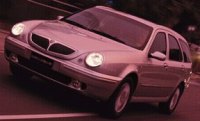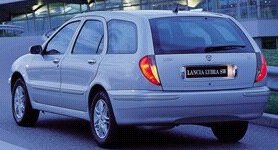 I
can’t remember for how long Lancia had been evacuated from the English
world. The last right-hand-drive Lancia was Dedra, which was really a
disappointing
car. Since then we could hardly read any review from magazines.
However,
our loss is not too much. When a mainstream car maker doesn’t produce
right-hand-drive
versions, the only reason is that its products are not competitive
enough
to justify the cost for conversion. Therefore, although Lancia
announced
the new Lybra, still LHD only, as a new direction for year 2000 and
beyond,
don’t believe it 100%. I
can’t remember for how long Lancia had been evacuated from the English
world. The last right-hand-drive Lancia was Dedra, which was really a
disappointing
car. Since then we could hardly read any review from magazines.
However,
our loss is not too much. When a mainstream car maker doesn’t produce
right-hand-drive
versions, the only reason is that its products are not competitive
enough
to justify the cost for conversion. Therefore, although Lancia
announced
the new Lybra, still LHD only, as a new direction for year 2000 and
beyond,
don’t believe it 100%.
As a late (better than none) successor to the 9-year-old Dedra, the Lybra takes the mission to revive Lancia’s reputation as a prestige marque rather than a rally aces. As Alfa Romeo is intended to be the sporty arm of the Fiat Group, Lancia has to face the up-hill battle against the like of Audi and Volvo, if not BMW and Mercedes. Sure, the success of Alfa 156 proves that nothing is impossible, but asking the Italian car maker to pursuit German standard of build quality seems more difficult. While the 156 is backed by the long-admired sporty image of Alfa Romeo, Lancia is not so lucky. People always remember the Delta Integrale and Stratos flying in the desert ... the muddy skirts, the broken front bumper, the Martini painting ... these do no favour to re-establish an image of prestige marque. Anyway, job has to be done. The Lybra uses various existing components in the group, including engines, gearbox and front suspension. The Alfa 156 rides on front double wishbones and rear MacPherson strut for maximum handling. The Lybra choose a different configuration for maximum ride comfort : front MacPherson strut and rear GLA (Guided Longitudinal Arm), this ensure it has a completely different character from the Alfa. You might not heard about GLA. In short, it is a combination of a trailing arm and a transverse arm. The latter looks like a long swing axle but actually it acts more like a MacPherson strut, especially is the coil spring and damper are attached to it. Unlike strut suspensions, the long transverse arm has the joint at the center of the car, thus for the same suspension travel it introduces less camber changes to the wheel. Obviously the transverse arm is used to control the handling. In contrast, the longitudinal trailing arm serves for ride comfort. When the wheel is rolling over an obstacle, the trailing arm let the wheel to lay back thus reduce impact. One shortcoming of trailing arm is the high unsprung weight of the arm. Lancia solved it by making it in aluminium alloy. On the other hand, GLA also reduces the space taken compare with MacPherson strut. Where strut has an concentric coil spring and damper unit locating upright thus engaging boot space, the GLA has the springs locating well below the boot level - it is pressed between the transverse arm and a subframe which is attached to the chassis via bushing. Therefore although the whole suspension is rather complex, it can be installed lowly and engage little usable space. The dampers still stand there like MacPherson strut, but in the absence of coil spring the space enaged is vastly reduced. This is the theory. Whether the GLA performs as good on road is left to be tested.
Apart from 5-speed manual, there is a 4-speed auto with adaptive electronic control and a Tiptronic-style manual override. Probably borrowed from Alfa’s Q-system. The
most important is probably the build quality. It is vastly improved
over
any previous Lancia but still not up to the level of German. So Lancia
complement this with a long list of equipments, including an unusually
high-spec dual zone climate control with pollution sensor, then a 200W
Bose HiFi system and a colour display built into the facia which
controls
satellite navigation, mobile phone, radio, trip counter etc.
|
| The above report was last updated on 8 Aug 99. All Rights Reserved. |
 Lybra
has nearly the same dimensions as the 156, so many unseen parts can be
carried over, such as the 2.2-turn rack-and-pinion steering. Engines,
however,
are shared with Fiat instead of Alfa. The base 103hp 1.6 comes from
Brava,
the 131hp VVT 1.8 is donated by Barchetta, the top-of-the-range
2.0-litre
five cylinder shares with Fiat Coupe. From this lineup you can see
Lancia
is not completely devoted to compete with the German prestige,
otherwise
there will be a V6 or at least Kappa’s 2.4-litre five. Anyway, the 2.0
unit is smooth, flexible and eager, thanks to the VVT, variable intake
manifold and balancer shaft. 154hp is sufficient to push the
1350-1380kg
kerb weight.
Lybra
has nearly the same dimensions as the 156, so many unseen parts can be
carried over, such as the 2.2-turn rack-and-pinion steering. Engines,
however,
are shared with Fiat instead of Alfa. The base 103hp 1.6 comes from
Brava,
the 131hp VVT 1.8 is donated by Barchetta, the top-of-the-range
2.0-litre
five cylinder shares with Fiat Coupe. From this lineup you can see
Lancia
is not completely devoted to compete with the German prestige,
otherwise
there will be a V6 or at least Kappa’s 2.4-litre five. Anyway, the 2.0
unit is smooth, flexible and eager, thanks to the VVT, variable intake
manifold and balancer shaft. 154hp is sufficient to push the
1350-1380kg
kerb weight.